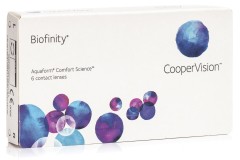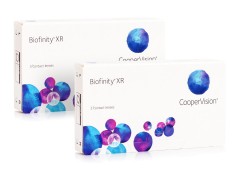Biofinity vs Biofinity XR
Compare Biofinity CooperVision (6 lenses) versus Biofinity XR CooperVision (6 lenses) contact lenses to choose the best and most reliable contacts for your specific needs.
Both models are monthly contacts that must be removed nightly for cleaning and storage using a contact lens solution. They’re convenient and cost-effective for regular contact lens wearers, requiring less frequent replacement compared to daily lenses.
These extended wear contacts provide breathability, convenience, and the option for occasional overnight use, pending approval from your eye care professional.
Check out the comparison table below to see a detailed description of the differences between Biofinity CooperVision (6 lenses) and Biofinity XR CooperVision (6 lenses) contact lenses:

|

|
|
| Biofinity CooperVision (6 lenses) | Biofinity XR CooperVision (6 lenses) | |
| Specifications | ||
|---|---|---|
| Power | from -12.0 to +8.0 | from -20 to -12.50 and from +8.5 to +15 |
| Diameter | 14.0 | 14.0 |
| Base curve | 8.6 | 8.6 |
| Center thickness | 0.08 mm | 0.08 mm |
| Elastic modulus | 0.75 MPa | 0.75 MPa |
| Lens features | ||
| Material | Comfilcon A | Comfilcon A |
| Water content | 48 % | 48 % |
| Oxygen transmissibility | 160 Dk/t | 128 Dk/t |
| UV filter | No | No |
| Silicone hydrogel | Yes | Yes |
| Usage | ||
| Expiration | At least 24 months | At least 35 months |
| Easy handling tint | Yes | Yes |
| Extended wear | Yes | Yes |
| Inside-out indicator | No | No |
| Package | ||
| Manufacturer | CooperVision | CooperVision |
| Lenses in a box | 6 | 6 |
| Weight | 31 g | 40 g |
| Other | ||
| Category | Monthly Contact Lenses Extended Wear Contact Lenses Silicone hydrogel contact lenses Contact Lenses Spherical and aspherical lenses |
Monthly Contact Lenses Extended Wear Contact Lenses Silicone hydrogel contact lenses Contact Lenses Spherical and aspherical lenses |
Main differences between Biofinity and Biofinity XR contact lenses
Biofinity
- Higher oxygen transmissibility
Biofinity XR lenses are designed for a wider range of prescriptions, including those with higher levels of refractive error.
Consider factors such as special features, materials, oxygen permeability, water content, and UV protection to determine the best option for your eye health and vision needs. Make sure to contact your eye care specialist to get recommendations tailored to your specific needs.
